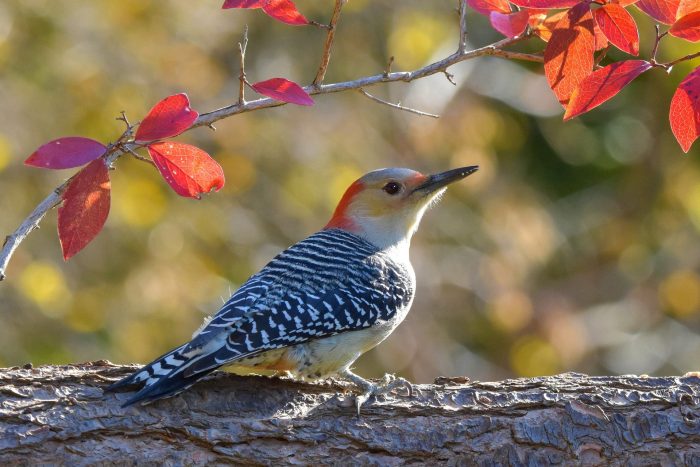By John L. Turner
Part One

Perhaps you remember, from those good ol’ days in high school biology, the phrase the teacher requested that you memorize: “Form begets function.” This truism reflects a universal fact that a strong correlation exists between the form of an animal or body part and the function it performs.
The long legs of a heron, for example, help it excel at wading in the shallow water of pond edges where it employs its long, dagger-like bill to spear fish and frogs. Similarly, the shape of a barnacle, growing on rocks in the intertidal portion of the ocean where crashing waves can dislodge anchored objects, is shaped to deflect wave energy.
Nowhere is this “form fits function” rule better exhibited than with our native woodpeckers, birds that grip the vertical surface of bark while hammering away on wood. Indeed, from head to tail woodpeckers are the epitome of the truism. Many of their physical features allow them to excel when pecking on wood.
Let’s start with the tail. Woodpecker tail feathers, especially the middle two, are quite stiff, much stiffer than, say, a blue jay feather. This rigidity is a major benefit as the tail serves as a brace, similar to a telephone lineman’s legs against the utility pole, helping to anchor the bird against the side of a tree. The other part of the anchor involves very strong feet equipped with sharp and powerful claws enabling the bird to maintain a firm grip, a grip enhanced because a woodpecker’s four toes are aligned with two toes in the front and two in the back to better grip bark, compared to a songbird’s foot with three toes in the front and one in the back.

These anchor points serve well as the woodpecker uses them to actively probe crevices in the bark, as well as to hammer away wood in search of grubs lurking beneath. And this is where the adaptations in the bird’s skull come into play. According to the definitive text on this bird group “Woodpeckers of North America,” a Pileated Woodpecker may strike with its bill, and by extension its skull, 12,000 times a day. Even more remarkably, the deceleration force each time can be as much as 1,200g. This is equivalent to a human hitting their head against a wall while running at 16 mph — each and every strike.
How does a woodpecker avoid damage to its brain and eyes from the constant hammering? To protect the brain, the skull has developed two thick spongy sections, one in front of the brain and the other behind it, which help to absorb the shock. In woodpecker species that spend a great deal of time hammering rather than pecking and flicking, this frontal section is larger. A woodpecker’s behavior can also reduce the impact of the blows by slightly changing the angle of each strike thereby preventing an impact to the same part of the brain with each blow.
A woodpecker’s eyes are also vulnerable to damage and, not surprisingly, here too they’ve evolved several adaptations to minimize damage. With the bird’s head moving at such speed and then coming to an immediate stop their eyes could be damaged and possibly pop out of their sockets. To prevent this, a nictitating membrane, sometimes referred to as a bird’s “third eyelid,” closes an instant before impact keeping eyes securely in their socket and preventing any wood chips from damaging the eyes. Similarly, a tuft of short feathers situated at the base of the upper bill serves to prevent chips from flying into the eyes.
The adaptations don’t stop here, as woodpecker’s tongues might be the most fascinating example of “form begeting function” in this unique group of birds. The shape of woodpecker tongues is quite diverse.

Sapsucker tongues, which as their name suggest, lick sap from holes (known as sap wells) they’ve created in tree bark, are brush-like to help lap up the liquid. In contrast, woodpeckers that search for beetle grubs in rotted wood have tongues that are stiff and barbed, with some possessing backward pointing spines like a fish hook to assist in extracting prey. Sticky saliva also helps in capturing prey.
If you stick out your tongue you can feel it is anchored to the bottom of your mouth, toward the back. Not so with woodpeckers. Remarkably, their tongues are not anchored in their mouths at all; they are anchored in their forehead near the base of the upper bill and wraps entirely around their skull. This makes the tongue quite extendable and in Northern Flickers means they can stick their tongues out a full two inches beyond the tip of the bill, a good skill to have for nabbing ants from a distance.
Virtually all woodpeckers are cavity nesters with most taking the time to excavate the nesting and roosting cavities they use. In this way, woodpeckers play a crucial role in providing nesting opportunities for other cavity nesting birds such as Screech Owls, Eastern Bluebirds, Black-capped Chickadees, Tufted Titmice, and Great-crested Flycatchers. In total, woodpecker cavities are used by more than 40 bird species in North America for nesting and roosting and provide shelter to several mammals such as flying squirrels and even some snake and lizard species.
Read Part II of Wonderful Woodpeckers in the issue of November 21 or click here.
A resident of Setauket, author John L. Turner is a naturalist, conservation co-chair of the Four Harbors Audubon Society, and Conservation Policy Advocate for the Seatuck Environmental Association.







